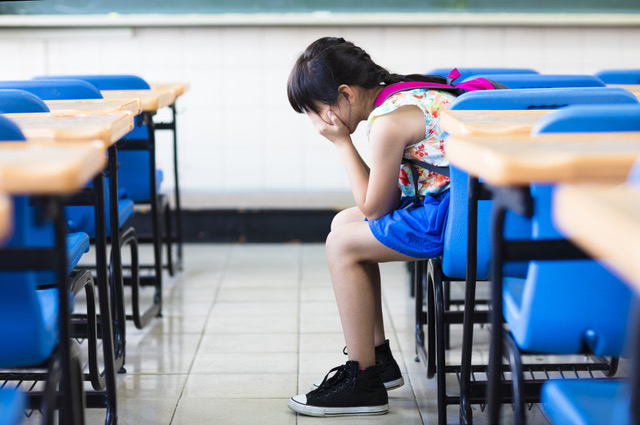Rude, Mean, or Bullying – And What to Do About It
Disclosure :: This post is sponsored by Episcopal School of Baton Rouge.
Seeing their child in pain is one of the hardest things a parent can experience.
When it is physical pain – a scraped knee or bump on the head – parents can put on a bandage and make it better. But what if your child’s pain is emotional rather than physical? What if another child at school is the source of your child’s pain? What if your child is being repeatedly targeted by a group of children? What if your child is being bullied?
At Episcopal, we encourage our students and families to report any bullying or harassment and make every effort to address the issue as quickly as possible. We have an official reporting process in our handbook, and we also use a reporting system called “Speak Up,” which allows students and parents to anonymously share concerns about themselves or other students.
When working with children and parents experiencing social challenges, it can be hard for them to define exactly what happened and harder still to figure out the best way to deal with it. Recently, I came across Licensed Social Worker Signe Whitson’s Psychology Today article that helps us tell the difference between rudeness, meanness, and bullying, and I’ve included some suggestions for how to handle each of these.
Rude
Rudeness is saying or doing something that inadvertently hurts someone else. For example, a child might break in line or make a thoughtless comment. The key is that the offense is usually unplanned and unintentional. While rudeness is common in childhood, that doesn’t mean it shouldn’t be addressed. This is a perfect opportunity for your child to utilize healthy confrontation strategies.
- Point it out in a calm manner to avoid defensiveness. “You just broke all of us in line. Would you mind moving to the back?” or “When you said that, it really hurt my feelings.” Simply pointing out the offense will often be enough to rectify the incident. If the situation escalates (e.g., pushing, name-calling, increased aggression), it is time to involve an adult.
Mean
Meanness is saying or doing something intentionally hurtful on one or two occasions. Unlike rudeness, the behavior is intentional. However, it is typically an isolated incident. It is often impulsive and motivated by anger or an attempt to increase social status by putting down someone else. Meanness may sound like, “I can’t believe you cut your hair like that. It looks so stupid.” or “You are such an idiot. Why do you even bother?”
Because there are various levels of meanness, it is more complex to address. Here are some ideas about how to deal with it.
- Talk to the offender in a personal setting, particularly if this is the first time an incident like this has occurred or if your child has a friendship with the person. People tend to become defensive in a group setting. Since meanness tends to be impulsive and isolated, the individual is more likely to be contrite.
- Ask a trusted adult to help facilitate a mediation. This may be necessary if there is not a previous relationship with the offender or if your child is not skilled in healthy confrontation. A school counselor, teacher, or coach can help with this.
Bullying
Bullying is hurtful, aggressive behavior that is Repetitive, Intentional, and involves an imbalance of Power. Remember the acronym RIP when assessing if there has been bullying. According to StopBullying.gov, types of bullying include:
- Verbal, or saying/writing mean things. Examples include teasing, name-calling, or verbal threats. This can also occur online, taking the form of cyberbullying.
- Social, or hurting a person’s reputation or relationships. This is sometimes called relational aggression, and is more common with girls. Examples are telling others not to be friends with someone, not including someone on purpose, spreading rumors, or public humiliation. This also can take the form of cyberbullying.
- Physical, or harming someone’s body and/or possessions. This is more common with boys. Examples include hitting or kicking, spitting, pushing, and taking/throwing/breaking someone’s things.
What should you do if your child is being bullied?
- Report bullying to the school, particularly if the incidents are occurring at school. Involve your child in this process as much as possible or as seems appropriate, as this can be empowering. You can make the report to the principal, dean of students, school counselor, or other administrator.
- Contact the police and/or seek medical attention. This would be in more extreme situations such as if a weapon was involved, there are threats of serious physical injury, or there is serious bodily harm or sexual abuse.
- Don’t ignore it, or assume that kids will work it out on their own. While it is important for children to learn conflict resolution skills, bullying is a pattern of aggression that should be addressed by adults.
- Provide support for your child. Listen to your child, reassuring him that the bullying is not his fault. However, it may be difficult for your child to talk about it initially.
- Make a plan to address the bullying. Ask your child what can be done to make her feel safe, such as changing seats in class or playing in a different area at recess. Communicate with the school, organizations, and/or parents to make sure they are aware and mindful of potentially risky situations.
What should you do if your child is engaging in bullying behaviors?
- Explain what the bullying behavior is and why it is problematic. Help him understand what he is doing and why it is not ok. Also, point out the potential consequences, including negative impacts for the victim.
- Allow your child to make amends to the victim. This can be done by making a supervised verbal apology or writing a letter of reflection and apology to the victim as well as replacing any property they may have damaged.
When your child is involved in a difficult social situation, it is important to take a moment to identify what is really happening – rudeness, meanness, or bullying. Once you know what is happening, then you can help your child address the incident appropriately. Helping your child develop these strategies is one way to help her develop the social skills necessary to living a happy and fulfilled life.
References
US Department of Health and Human Services. (2017). “Respond to Bullying.” Retrieved from https://www.stopbullying.gov/respond/on-the-spot/index.html
US Department of Health and Human Services. (2017). “Support the Kids Involved.” Retrieved from https://www.stopbullying.gov/respond/support-kids-involved/index.html
US Department of Health and Human Services. (2017). “What is Bullying?” Retrieved from https://www.stopbullying.gov/what-is-bullying/index.html
Whitson, S. (2012). “Is it Rude, is it Mean, or is it Bullying?” Retrieved from https://www.psychologytoday.com/us/blog/passive-aggressive-diaries/201211/is-it-rude-is-it-mean-or-is-it-bullying


















